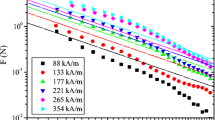Abstract
Based on the single-chain structure model of magnetorheological fluids, a formula for the calculation of shear stresses was established. The interaction force of two magnetic particles in an infinite single-chain was deduced using a new theoretical model which is founded on Ampere’ molecular current hypothesis, dipole theory and Ampere’ law. Furthermore, the resultant force on a particle was then deduced by taking into account of the action caused by all the other particles in the single-chain. A predictive formula for shear stresses was made corresponding to the case that MR fluids were sheared by a small angle and the calculating results fit well on the order with the yield stresses of the commercial MR fluids.
Similar content being viewed by others
References
J M Ginder and L C David. Shear Stress in Magnetorheological Fluids: Role of Magnetic Saturation.Appl. phys. lett., 1994, 65(26):2410–3412
JIN Yun. Numeric Computation on Shear Yield Stress of Magnetorheology Fluids.Journal of China University of Science and Technology, 2001, 31(2):168–173 (in Chinese)
WANG Jian xiao, MENG Guang. Research Advances in Magnetorheological Fluids.Acta Aeronautica Et Astronautica Sinica, 2002, 23, (1):6–12 (in Chinese)
WANG Qi-min,et al. The Rheological Property and Engineering Application of Magnetorheological (MR) Fluids.Chinese Mechanical Engineering, 2002, 13(3):267–270 (in Chinese)
Mark R Jolly, Jonathan W Bender, J David Carlson. Properties and Applications of Commercial Magnetorheological Fluids.Journal of Intelligent Material Systems and Structure, 1999, 10:5–13
W Kordonski, S Gorodkin and N Zhuravski. Static Yield Stress in Magnetorheological Fluid.International Journal of Modern Physics B, 2001, 15(6–7):1078–1084
Rosenweig R E. On Magnetorheology and Electrorheology as State of Unsymmetric Stress.J. Rheol., 1995, 39(1):179–192
Bossis G and Lemaire E. Yield Stresses in Magnetic Suspensions.J. Rheol. 1991, 35(7):1345–1354
Lemaire E and Bossis G. Yield Stress and Wall Effects in Magnetic Colloidal Suspensions.J. Phys. D: Appl. Phys., 1991, 24:1473–1477
D J Klingenberg and C F Zukoski IV. Studies on the Steadyshear Behavior of Electrorheological Suspensions.Langmuir, 1990, 6,(1):15–24
Janine Larie Fales. A Three Dimensional Study of Nonlinear Particle Magnetization in an Idealized Magnetorheological Fluid. Doctor Thesis of University of California, 2001
GAO Xiang yang, ZHAO Xiao peng, ZHENG Chang qing. Interaction of Chains in Electrorheological Fluids.Acta Mechanica Sinica, 2000, 32(1):94–97 (in Chinese)
YI Pu teng.Simple Tutorial of Electromagnetics. Bei Jing: Publishing Company of Bei Jing Normal University, 2001:162–168 (in Chinese)
YIN Zhen.Dynamoelectric Mechanics. Nan Jing: Publishing Company of Nan Jing University, 1999:78–89 (in Chinese)
Author information
Authors and Affiliations
Corresponding author
Additional information
Funded by the “863” Hi-tech Research and Development Program of China (No. 2001AA33P020)
Rights and permissions
About this article
Cite this article
Changchun, Z., Pengcheng, Z., Lisheng, L. et al. A new theoretical model about shear stress in magnetorheological fluids with small shear deformation. J. Wuhan Univ. Technol.-Mat. Sci. Edit. 20, 52–56 (2005). https://doi.org/10.1007/BF02870873
Received:
Accepted:
Issue Date:
DOI: https://doi.org/10.1007/BF02870873




